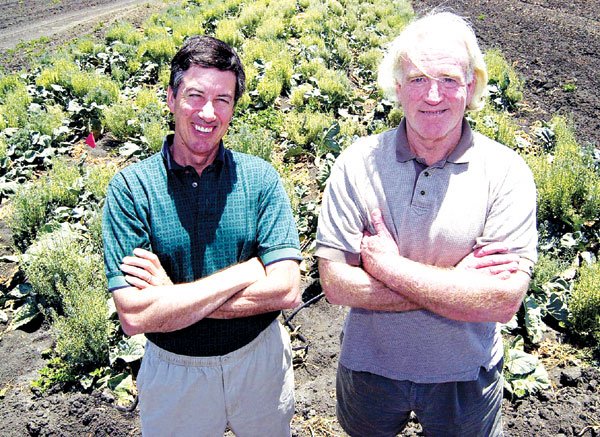GILROY
– Gilroy seed researchers are devising a variety of broccoli
that won’t break a sweat even when temperatures soar above 100
degrees.
GILROY – Gilroy seed researchers are devising a variety of broccoli that won’t break a sweat even when temperatures soar above 100 degrees.
Normally, broccoli does best in temperatures between 40 and 70 degrees. It is generally grown in the late spring and early fall and almost exclusively along the California coast to avoid warmer temperatures. Exposure to heat can cause irregular heads and brown buds.
“Sometimes even if you grow it in a cool place, like the Salinas Valley, you’ll get a hot day or two, and it messes it up,” said Robert Barham, a seed researcher from Gilroy.
Barham and David Joynt, owners of R&D Agriculture, will be planting three to four acres of broccoli in a field along Pacheco Pass with seedlings of their new breed next week, hoping the plants will endure Gilroy’s sometimes sweltering summer heat.
“Broccoli can’t normally stand over 80,” Barham said. “This was almost like going to color TV from black and white. It can take 110 if you give it enough water. It’s amazing.”
When their plants mature, they’ll put their genetically modified broccoli to the test.
“Every summer we run our broccoli beauty contest and pick the best out of those,” he said.
R&D looks for plants that resist mildew, have smooth domes, have uniform flower buds and are green to blue-green in color. Plants that pass muster will be re-bred to produce these desired qualities, while ones that fail will be thrown out.
Barham and Joynt founded R&D Agriculture 14 years ago. Because they were a small company, the partners decided to specialize in broccoli.
Gilroy was the ideal climate for their experiments, said Barham, who has a doctorate in plant genetics.
“After three or four years, we were astounded by what we were starting to see,” he said. “It was material that could withstand heat over 100 degrees.”
Currently, broccoli grows best in Monterey County, with its cool and consistent coastal climate. More than half of the state’s broccoli is harvested in Monterey County. According to the most recent crop report for Santa Clara County, 5.4 tons of broccoli were harvested in the county in 2002 with a total value of $1,647,000.
In the end, Barham and Joynt hope their research will allow growers to rotate the crop throughout the year or move to cheaper land. Land in Monterey County cost more than $3,000 an acre in 2002. Also, if broccoli could be grown in more areas, it would cut down on the shipping costs.
“It could be grown right next to New York City, rather than shipped all of the way to New York City,” Joynt said.
Very few farmers in Gilroy grow it, Barham said.
Uesugi Farms grows mostly chili and bell peppers and also Napa cabbage and strawberries on its 1,000 acres, which stretch from the Coyote Valley to Hollister. Sales Manager Pete Aiello was impressed by R&D’s results with broccoli, however he doubted Uesugi would start growing broccoli.
“We have certain commodities that we’ve grown for many, many years that we’re good at growing. However, I could see this open a lot of doors where the weather is hot,” Aiello said.
Now, R&D Agriculture is in the process of applying for a patent, which should take up to another month and a half to win final approval. Barham described the process as “long and tedious and expensive.”
Soon, they will be embarking on an even more difficult endeavor: producing enough seed to distribute worldwide.
“Seed production is always a huge bottleneck for anything,” said Joynt, who focuses on marketing and production.
The Hollister resident said R&D will start seed plants in late summer, which will take a year and a half to grow. It’ll take more time to reliably predict how many pounds of seed they can produce and deliver.
So how does it taste?
“Broccoli is generally mild,” Barham said. “We select for that mildness. Most people want to get that flavor from butter, salt and cheese.”
No matter how it’s prepared, Joynt – like George Bush Sr. – probably won’t touch it on his dinner plate.
“I eat it in the field,” he said. “Cooked for dinner at home, I just will pass. (It’s) not one of my favorites.”
The Associated Press contributed to this story.













